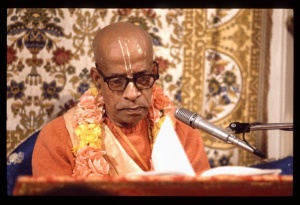SB 2.10.28: Difference between revisions
m (1 revision(s)) |
(Vanibot #0054 edit - transform synonyms into clickable links, which search similar occurrences) |
||
| (One intermediate revision by one other user not shown) | |||
| Line 1: | Line 1: | ||
{{info | {{info | ||
|speaker= | |speaker=Śukadeva Gosvāmī | ||
|listener=King | |listener=King Parīkṣit | ||
}} | }} | ||
[[Category:Srimad-Bhagavatam - Canto 02 Chapter 10]] | |||
[[Category:Bhagavatam Verses Spoken by Sukadeva Gosvami - Vanisource|021028]] | |||
<div style="float:left">'''[[Srimad-Bhagavatam]] - [[SB 2|Second Canto]] - [[SB 2.10: Bhagavatam Is the Answer to All Questions|Chapter 10: Bhagavatam Is the Answer to All Questions]]'''</div> | |||
<div style="float:right">[[File:Go-previous.png|link=SB 2.10.27]] '''[[SB 2.10.27]] - [[SB 2.10.29]]''' [[File:Go-next.png|link=SB 2.10.29]]</div> | |||
{{RandomImage}} | |||
==== TEXT 28 ==== | ==== TEXT 28 ==== | ||
<div | <div class="verse"> | ||
āsisṛpsoḥ puraḥ puryā | :āsisṛpsoḥ puraḥ puryā | ||
nābhi-dvāram apānataḥ | :nābhi-dvāram apānataḥ | ||
tatrāpānas tato mṛtyuḥ | :tatrāpānas tato mṛtyuḥ | ||
pṛthaktvam ubhayāśrayam | :pṛthaktvam ubhayāśrayam | ||
</div> | </div> | ||
| Line 16: | Line 22: | ||
==== SYNONYMS ==== | ==== SYNONYMS ==== | ||
<div | <div class="synonyms"> | ||
''[//vanipedia.org/wiki/Special:VaniSearch?s=āsisṛpsoḥ&tab=syno_o&ds=1 āsisṛpsoḥ]'' — desiring to go everywhere; ''[//vanipedia.org/wiki/Special:VaniSearch?s=puraḥ&tab=syno_o&ds=1 puraḥ]'' — in different bodies; ''[//vanipedia.org/wiki/Special:VaniSearch?s=puryāḥ&tab=syno_o&ds=1 puryāḥ]'' — from one body; ''[//vanipedia.org/wiki/Special:VaniSearch?s=nābhi&tab=syno_o&ds=1 nābhi]-[//vanipedia.org/wiki/Special:VaniSearch?s=dvāram&tab=syno_o&ds=1 dvāram]'' — the navel or abdominal hole; ''[//vanipedia.org/wiki/Special:VaniSearch?s=apānataḥ&tab=syno_o&ds=1 apānataḥ]'' — was manifested; ''[//vanipedia.org/wiki/Special:VaniSearch?s=tatra&tab=syno_o&ds=1 tatra]'' — thereupon; ''[//vanipedia.org/wiki/Special:VaniSearch?s=apānaḥ&tab=syno_o&ds=1 apānaḥ]'' — stopping of the vital force; ''[//vanipedia.org/wiki/Special:VaniSearch?s=tataḥ&tab=syno_o&ds=1 tataḥ]'' — thereafter; ''[//vanipedia.org/wiki/Special:VaniSearch?s=mṛtyuḥ&tab=syno_o&ds=1 mṛtyuḥ]'' — death; ''[//vanipedia.org/wiki/Special:VaniSearch?s=pṛthaktvam&tab=syno_o&ds=1 pṛthaktvam]'' — separately; ''[//vanipedia.org/wiki/Special:VaniSearch?s=ubhaya&tab=syno_o&ds=1 ubhaya]'' — both; ''[//vanipedia.org/wiki/Special:VaniSearch?s=āśrayam&tab=syno_o&ds=1 āśrayam]'' — shelter. | |||
</div> | </div> | ||
| Line 23: | Line 29: | ||
==== TRANSLATION ==== | ==== TRANSLATION ==== | ||
<div | <div class="translation"> | ||
Thereafter, when He desired to move from one body to another, the navel and the air of departure and death were combinedly created. The navel is the shelter for both, namely death and the separating force. | Thereafter, when He desired to move from one body to another, the navel and the air of departure and death were combinedly created. The navel is the shelter for both, namely death and the separating force. | ||
</div> | </div> | ||
| Line 30: | Line 36: | ||
==== PURPORT ==== | ==== PURPORT ==== | ||
<div | <div class="purport"> | ||
The prāṇa-vāyu continues the life, and the apāna-vāyu stops the living force. Both the vibrations are generated from the abdominal hole, the navel. This navel is the joint from one body to the other. Lord Brahmā was born of the abdominal hole of Garbhodakaśāyī Viṣṇu as a separate body, and the same principle is followed even in the birth of any ordinary body. The body of the child develops from the body of the mother, and when the child is separated from the body of the mother, it is separated by cutting the navel joint. And that is the way the Supreme Lord manifested Himself as separated many. The living entities are therefore separated parts, and thus they have no independence. | The ''prāṇa-vāyu'' continues the life, and the ''apāna-vāyu'' stops the living force. Both the vibrations are generated from the abdominal hole, the navel. This navel is the joint from one body to the other. Lord Brahmā was born of the abdominal hole of Garbhodakaśāyī Viṣṇu as a separate body, and the same principle is followed even in the birth of any ordinary body. The body of the child develops from the body of the mother, and when the child is separated from the body of the mother, it is separated by cutting the navel joint. And that is the way the Supreme Lord manifested Himself as separated many. The living entities are therefore separated parts, and thus they have no independence. | ||
</div> | </div> | ||
__NOTOC__ | |||
<div style="float:right; clear:both;">[[File:Go-previous.png|link=SB 2.10.27]] '''[[SB 2.10.27]] - [[SB 2.10.29]]''' [[File:Go-next.png|link=SB 2.10.29]]</div> | |||
__NOTOC__ | |||
__NOEDITSECTION__ | |||
Latest revision as of 21:12, 17 February 2024

A.C. Bhaktivedanta Swami Prabhupada
TEXT 28
- āsisṛpsoḥ puraḥ puryā
- nābhi-dvāram apānataḥ
- tatrāpānas tato mṛtyuḥ
- pṛthaktvam ubhayāśrayam
SYNONYMS
āsisṛpsoḥ — desiring to go everywhere; puraḥ — in different bodies; puryāḥ — from one body; nābhi-dvāram — the navel or abdominal hole; apānataḥ — was manifested; tatra — thereupon; apānaḥ — stopping of the vital force; tataḥ — thereafter; mṛtyuḥ — death; pṛthaktvam — separately; ubhaya — both; āśrayam — shelter.
TRANSLATION
Thereafter, when He desired to move from one body to another, the navel and the air of departure and death were combinedly created. The navel is the shelter for both, namely death and the separating force.
PURPORT
The prāṇa-vāyu continues the life, and the apāna-vāyu stops the living force. Both the vibrations are generated from the abdominal hole, the navel. This navel is the joint from one body to the other. Lord Brahmā was born of the abdominal hole of Garbhodakaśāyī Viṣṇu as a separate body, and the same principle is followed even in the birth of any ordinary body. The body of the child develops from the body of the mother, and when the child is separated from the body of the mother, it is separated by cutting the navel joint. And that is the way the Supreme Lord manifested Himself as separated many. The living entities are therefore separated parts, and thus they have no independence.